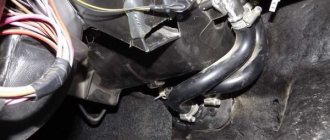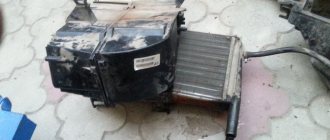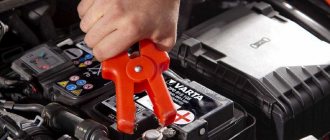And yet: is it necessary to close the car radiator in winter and the relevance of the “cardboard”
Theoretical effect
It is better to learn how to properly close the radiator for the winter from experienced drivers. There’s nothing complicated about it, but some extra advice won’t hurt. Be interested in what and how, preferably after mastering it, why it is needed and getting an answer to the question whether this method of insulation actually helps. Making a final decision is possible only if the needs of the owner and the guarantees of this method of thermal insulation coincide.
Restricting air access to the engine through the radiator grille in winter gives:
- Reducing the time it takes to fully warm up the engine during frequent short trips.
- Acceleration of coolant reaching operating temperature when warming up the power plant while driving.
- Preservation of heat in the engine compartment when driving on the highway.
Practical significance
Premium cars have long been equipped with a system of dampers that regulate the volume of air flowing over the engine. Ensuring that the power plant quickly reaches operating temperature and maintaining it within specifications helps preserve the factory life of internal combustion engine parts.
Natural thermal conditions in cold weather are only beneficial and here’s why:
- Reducing the warm-up time leads to a decrease in fuel consumption, since the ECU generates an over-rich mixture when it is cold.
- Reducing the proportion of air cooling at high speed allows the interior heater to operate at full capacity.
The help of insulation is especially noticeable at temperatures below -20°C: the computer displays suburban fuel consumption values close to summer values, and the stove heats up noticeably even at idle. This fact is confirmed by both owners of carburetor cars and owners of injectors. However, you can only get by with an additional homemade car interior heater designed for 12 Volts.
The position of companies specializing in the production of insulating components is clear. Often, when asked whether it is necessary to close the radiator in winter, they put forward additional arguments in favor:
- Fuel savings up to 25%.
- Eases cold starts.
- Increased battery life.
It is quite clear that the savings percentage is overestimated, and the closed radiator grill does not affect the morning start-up in any way - the engine managed to freeze overnight. There is also no gentle operation of the battery, since you still have to turn the crankshaft in thick oil.
Content
How to insulate a car radiator for the winter is a rather multifaceted question; there are several different ways to carry out this work. At the same time, there are several myths circulating among drivers about this modification of the cooling system. Despite the fact that they are not true, these myths are quite tenacious and popular:
- Reducing fuel consumption by 20% when using special protective equipment. This myth is inspired by the advertising efforts of manufacturers of such insulation. In practice, of course, fuel consumption is slightly reduced due to faster warm-up. But the savings are much lower. But such kits are very expensive;
- Insulating the radiator makes it easier to start the engine in the morning. If your car has been parked for only a couple of hours, the insulation will retain some of the heat, and the engine will start faster and easier. Having stood in the cold all night, the engine will cool down even with very good insulation. Therefore, insulating the radiator will not give you any advantage when starting up.
Now that you have become familiar with the mythology of insulating the radiator and engine compartment, you can begin the actual work of protecting this part of the car from the cold.
Proper insulation or how to properly close the engine radiator for the winter: technologies and tips
The positive results from thermal insulation of the radiator grille are due to the fact that the engine consumes less resources to achieve and maintain operating temperature than with air cooling in winter. An additional effect is the protection of the heat exchanger honeycombs from the ingress of road reagents, which leads to an increase in corrosion resistance and preservation of the factory life of the part.
Requirements
Disrupting air cooling can cause harm. Untimely and hasty cover of the radiator grille leads to overheating of the engine. You can reduce the likelihood of thermal imbalance, and the following tips will help you do this:
- Do not lean the element directly against the radiator - there must be a gap between the heat exchanger and the thermal insulation.
- Install insulation at a temperature of -10°C or less.
- Do not cover the entire area of the heat exchange element.
For your information. The rules apply to both petrol and diesel versions.
A trivial method of insulation is to insert between the heat exchanger and the bumper a piece of cardboard cut from the box of some household product to certain dimensions. A heat exchange element covered 2/3 in this way is a simple solution to the problem of how to properly close a car radiator for the winter using improvised means.
Owners of cars equipped with air conditioning will benefit from another method of insulation: insert a newspaper between the condenser and the main heat exchanger. The total thickness of the sheets should be such that they move freely between the walls of the radiators.
The disadvantage of quick methods is that they ruin the aesthetics of the front of the vehicle and are not as effective in severe frosts. However, advanced ideas require costs, but the effect is better:
- A set of dampers designed for a specific vehicle.
- External masks for radiator grilles.
- Homemade imitation of branded shields.
Factory products
Model-specific plastic covers are attached invisibly. The shape of the damper closely follows the geometry of the radiator grille and does not cover the car manufacturer’s emblem. Synthetic masks, for example, from the Tammers company, hide the architecture of the decorative sieve, and external quick-release fasteners are not to everyone’s taste.
The price of such a solution will not suit everyone. A plastic shield will cost 500-700 rubles. An impact-resistant and waterproof mask made of synthetic fabric costs about 3,000 rubles.
Car blanket
At the moment, auto parts stores have a very wide selection of car engine blankets. We recommend choosing products filled with kaolin wool. This is a reliable, durable and practical material that retains heat well.
In addition to low thermal conductivity, such products are fire-resistant and can withstand temperatures up to 1200 ° C. In addition, they are immune to the effects of aggressive liquids, so they will withstand contact with electrolyte, fuels and lubricants and operating fluids without consequences.
Verdict
Insulating the radiator speeds up the engine's return to operating thermal conditions and helps maintain it in severe frosts, which will have a positive effect on fuel consumption and the operation of the standard stove. A simple and working way is to place a piece of cardboard in front of the heat exchanger.
A more effective measure is to cover the radiator grille from the inside with foil insulation or with dermantine from the outside: the absence of cold air blowing over the parts of the power plant helps to speed up warming up while driving. Factory-made sets of overlays and masks are no less effective, but are expensive and do not always comply with the aesthetic picture.
Features of engine insulation
The last thing I would like to mention if you have insulated your engine is that you still need to monitor the operating temperature of your power plant.
So, during a thaw in winter or spring, if you hesitate a little and forget about your insulation, this threatens the engine with overheating. It is necessary to quickly and effectively respond to changes in outside temperature by promptly removing the cape from the engine compartment or the cardboard installed behind the radiator grille. It is these actions on your part that will not only ensure your comfort, but also optimal engine operating conditions. vote
Article rating
How to close the radiator grille for the winter and when to do it
Hello everybody! The cold weather is getting closer, and therefore it’s time to discuss winter topics. Let's start with how to close the radiator grille for the winter, whether it is necessary to do this and whether there is any point in such actions.
Moreover, the question of the relevance of using this old-fashioned method will be considered in relation to old and modern cars. There is a significant difference between them, although in both cases cardboard continues to be used.
Let's find out whether it is necessary to do something like this, whether it is possible to use such overlaps at all, what this will potentially give and what problems it will save from.
Old cars
The tradition, according to which drivers consider it necessary to protect the radiator of their car, appeared quite a long time ago.
This can be attributed to the 70-80s of the last century, when certain mechanisms of the radiator of the engine cooling system were used on cars.
Previously, on cars, the radiator was cooled by a fan, which operated due to the operation of a belt drive directly from the crankshaft. It was the crankshaft that was responsible for spinning the fan blades. An extremely simple principle was applied here. The faster the vehicle traveled, the faster the blades spun. Due to this, more air was supplied to the radiator, and it cooled more actively.
The negative aspect of the situation is quite obvious. The driver did not have the opportunity to control or somehow influence the operation of the fan, depending on the outside air temperature.
In simple terms, even in the cold winter, when the car accelerated strongly enough, the fan spun very quickly. This entailed problems with the operation of the motor, which simply did not have time to heat up to operating temperature.
This, by the way, relates to the question of whether it is necessary to warm up the engine in winter and summer. Read the material at the link, a lot will become clear.
In winter, due to insufficient heating, when the internal combustion engine simply could not reach its normal operating temperatures, corresponding malfunctions arose. But even in summer, such active cooling had its negative aspects. For example, at high speed the engine was well cooled. But when the car had to idle for a long time, overheating occurred. This is due to the low speed and high temperature outside. The fan did not have enough effort to cool the radiator and the motor itself, respectively.
As you understand, then it was really necessary to limit the incoming air flow to the radiator. For this purpose, cardboard, an improvised apron, a blanket and other similar solutions were used.
Modernization and improvement of the stove
While processing the interior, you should immediately check the functionality of the heating system. On the VAZ-2107, the heater design has some design flaws. In addition, over time, the seals of the housing and air ducts cease to perform their function, which leads to the dissipation of the flow of warm air.
The main design flaw in the VAZ-2107 is insufficient fan characteristics (power, number of revolutions). To eliminate this drawback, you can replace the standard electric motor with an electric one. the motor is from a VAZ-2108, but for this you will have to slightly modify the fan housing. But we note that in addition to the motor, you need to immediately change the fuse and rheostat.
A more significant modification is the installation of a VAZ-2108 fan into the stove along with the housing (“Snail”). Such an upgrade will not only provide a powerful air flow, but will also operate more quietly.
When working with the stove, it is worth disassembling the air ducts, cleaning them thoroughly, and putting the structure back together, installing new seals. Additionally, the joints can be covered with insulating materials (the same vibration isolator) to eliminate the possibility of air leakage. The same should be done with the stove body.
If the heat exchanger of the stove warms up poorly, it may require flushing or replacement. The pipes in the interior radiator have a small cross-section, so over time they become clogged with dirt, which greatly reduces heat transfer.
If the radiator is very dirty, it is difficult to wash the dirt out of it, so in such cases it is easier to buy a new one.
Modern cars
We've sorted out the old cars. But the question remains open as to why such solutions, like cardboard, not to mention a car blanket, are used on modern vehicles.
Modern cars include models produced closer to the 2000s, as well as all current cars. Namely:
- Lada Priora;
- Lada Granta;
- Renault Logan;
- Kia Rio;
- Renault Duster;
- Passat B6;
- VAZ 2110;
- Ford Focus;
- VAZ 2107;
- Hyundai Solaris, etc.
Modern cooling systems differ significantly from those discussed in the previous section.
Now the fan turns on automatically as needed. This happens when the temperature sensor is triggered. Forced cooling is switched on when the internal combustion engine reaches its maximum temperature.
Usually we are talking about warming up to 90-95 degrees Celsius.
To monitor temperature changes, the system is equipped with a thermostat. The control system is electronic; it is in no way tied to the crankshaft. This allows the engine not to boil, even when it is very hot outside. At the same time, in winter the fan turns on extremely rarely, since the radiator has enough outside air to cool the system. But even in this case, drivers still continue to use cardboard and other similar means.
Some people simply put a piece of cardboard, others make a car blanket with their own hands and use other options for insulating a car for the winter, which we have already told you about in previous materials.
This makes sense. The presence of limiters allows you to more effectively retain hot air in the engine. The engine is insulated, and therefore it is easier for it to start in winter. At the same time, fuel consumption decreases and the cabin becomes warmer.
Salon
After completion of work with insulation of the engine compartment, the next stage is thermal insulation of the car interior.
The goal of the car enthusiast here is clear - to retain heat in the car interior and speed up the heating of the interior by the stove in winter.
This work is relevant not only for cars of the domestic automobile industry (for obvious reasons), but also for foreign cars.
Thanks to high-quality insulation and effective athermal tinting, it is possible to maintain heat in the cabin longer, even without turning on the stove.
At the same time, modern materials provide excellent sound insulation, which provides additional comfort during the trip.
How to close the radiator on a Lada Vesta - personal advice, apron pattern
Protection of the cooling radiator in the form of a mesh protects it from dirt. Thermal protection serves to insulate the engine so that it cools down more slowly. Lada Vesta is equipped with a beautiful plastic grille that covers the radiator. Nice large cells are capable of letting a lot of dirt, sand, and insects through, which quickly clog the honeycombs. Therefore, motorists install an additional fine mesh. Before closing the Vesta radiator, you will need to partially disassemble the upper part of the bumper.
Should I close it in winter?
There is no definite answer, it depends on the climate in your area and how you drive your car. You can drive on an intercity highway or around the city, the difference will be noticeable. If you have a warm climate, the weather rarely gets colder than -15 degrees, and you drive around the city, then you do not need to insulate the engine on Vesta. Otherwise, the motor may overheat.
If the frost is below -25 degrees, and you have to travel long distances, then it is better to insulate the Vesta engine. On such trips, the technological plug, oil seals or oil dipstick are often squeezed out of the motor housing. As a result, oil leaks. This happens due to long driving in the cold.
Oil vapor in the crankcase ventilation system freezes. A plug forms, which causes excess pressure. Therefore, whether to close the radiator in winter is up to you. Analyze your operating mode and make the right decision.
How to insulate the bumper and engine of Vesta
There are several ways to insulate engines with your own hands:
- Cover the radiator on the Lada Vesta with available material, for example, cardboard. It is installed between the radiator and the bumper grille. With such protection, you will not speed up the engine warming up, and the engine will cool down just as quickly with cardboard. It will only have an effect while moving. The radiator will not be cooled by oncoming air and will not give off heat. Therefore, while driving, warming up will go faster, and gasoline will be saved.
- How to insulate a Vesta engine under the hood for the winter? For this purpose, special insulation is used. They retain heat to warm up the engine faster at idle. During parking, the insulated power unit cools down more slowly, which has a positive effect on gasoline consumption.
When driving in a city traffic jam with the bumper closed, the engine will overheat due to lack of airflow. Monitor the engine temperature!
This method of engine insulation is not dangerous. It is important to choose the right material for insulation. It must be fireproof and retain heat well. Typically, insulation with foil is used, which reflects heat into the engine compartment. These are penofol, isolon and other materials with a layer of foil.
Do not allow the foil to touch the battery terminals - a short circuit may cause a fire!
Felt retains heat better and is non-flammable. But if it comes into contact with the exhaust manifold, smoldering of the material may occur. The car blanket, recommended by experts and heavily advertised in various sources, does not burn and retains heat. But its cost is higher than other materials, so the car blanket is not very popular among ordinary drivers.
How to insulate a bumper, and whether it is necessary on a new Russian car, depends on several factors. These are driving style, driving mode, financial capabilities and the ability to work with your hands.
Arguments of insulation supporters
- Insulating a car's radiator allows the engine to warm up faster.
- Insulating the radiator grille helps to warm up the interior faster.
- An insulated radiator helps maintain optimal engine temperature when driving quickly (for example, on the highway).
Let's take a closer look at these statements.
This makes the engine warm up faster
Let's imagine what will happen if you insulate the radiator grill of a car.
In severe frosts, before starting the engine, the air under the hood is at ambient temperature. During operation of the power unit, it gradually heats up. If the air heats up, then it is logical to assume that it heats up due to the fact that the heating engine shares heat with it. If the motor shares heat with something, it means that it itself cools down. Consequently, cold air under the hood in winter prevents the engine from warming up.
The heated air, in turn, heats the hood and all other parts of the car. It also vents outside through the vents and radiator. During this heat exchange with the environment, the air enveloping the engine is cooled again, and again prevents the engine from warming up quickly.
In order to minimize heat loss during engine warm-up, it is necessary to “clog” the engine compartment as much as possible and, thus, create a space isolated from the environment. To do this, you can close the ventilation holes to allow hot air to escape from under the hood, cover (for example) the engine with a “car blanket” and insulate the car radiator for the winter.
Is it worth carrying out the described procedures? I think yes. The engine should really warm up faster due to the fact that during warming up, using these measures, we minimize the flow of cold air from the outside.
This makes the interior warm up faster
The statement is true - this conclusion can be drawn by analogy with the previous statement and analysis of its validity. If you ensure maximum tightness of the engine compartment, you can hope that the engine will warm up faster. And since the car’s interior is warmed up by the engine, it is logical to assume that its warming up will occur faster. Therefore, the question of whether it is worth insulating the radiator to warm up the car interior faster can be answered positively.
This way you can maintain the optimal temperature
The question of whether it is worth insulating a car radiator in winter in order to maintain the optimal operating temperature of the engine while driving cannot be answered unambiguously. Judging by my experience (and I have never insulated anything), the engine always had an optimal 90-100 degrees when driving. True, I’m not a fan of operating a car in frosts of -30 or below.
If in your case, traveling in such conditions is necessary, and you see that at speed in cold weather the thermometer needle drops below the operating range, then the need for insulation is certainly justified.
DIY winter protection
You can make an apron for Vesta yourself using a ready-made pattern or pattern. The picture shows all the dimensions for cutting out the radiator protection for winter.
The apron can be made of leatherette with a layer of insulation. At the place where the car number plate is attached, the apron can be made without cutouts. The license plate can be secured over the apron with self-tapping screws.
Fastening homemade protection to the grille is offered in the form of plastic clamps.
After such an upgrade, the temperature of the power unit in bitter cold will not fall below 85 degrees.











